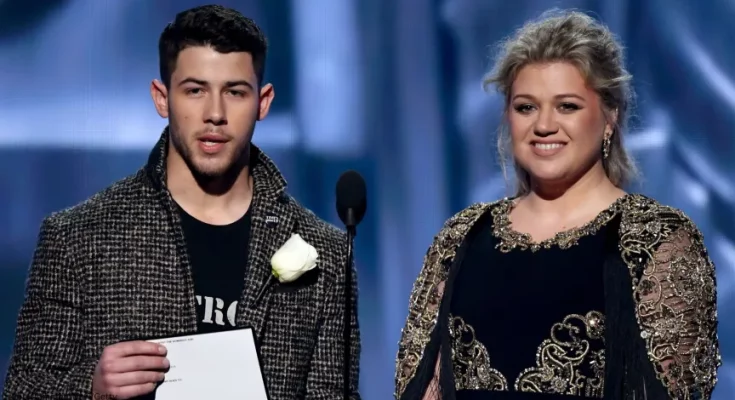Steve Martin, Kelly Clarkson, and Nick Jonas are names that resonate across very different corners of the entertainment world. Steve Martin, a comedy legend, is known not just for his stand-up and acting but also for his virtuosic skill on the banjo, bridging the worlds of comedy, film, and bluegrass music. Kelly Clarkson, the powerhouse singer and original “American Idol” winner, has become a defining voice in pop-rock music over the past two decades, celebrated for her vocal strength, emotional depth, and genre versatility. Nick Jonas, who first came into the limelight as part of the Jonas Brothers, has evolved into a multifaceted musician, actor, and songwriter, exploring pop, rock, and R&B influences in his solo career. Each of these artists operates in very different spheres, and it would be easy to imagine that their paths would rarely cross professionally. Yet, in a surprising and delightful musical collaboration, these three icons have come together to create a song that showcases the unexpected synergy of comedy, pop, and musical virtuosity in a way few would have predicted.
The collaboration initially seems improbable because of the stark contrasts in their public personas and artistic styles. Steve Martin is often seen primarily as a comedic actor, a staple in American humor, and his musical pursuits, while respected, occupy a niche of bluegrass and banjo-focused performance that is far from mainstream pop. Kelly Clarkson is recognized for her anthemic hits and emotional vocal delivery, frequently commanding charts and award stages, while Nick Jonas occupies the contemporary pop landscape, often incorporating electronic and R&B influences into his music. Despite these differences, what unites them is a shared appreciation for music that transcends categories and an understanding of performance that connects with audiences on multiple levels. This collaboration is a testament to the idea that creativity flourishes when seemingly incompatible elements are brought together to form something fresh and unexpected.
The song in question brings these distinct voices together in a way that highlights each artist’s strengths while creating a unified musical narrative. Steve Martin’s contribution on the banjo adds a unique texture and rhythmic foundation that immediately differentiates the track from standard pop or rock songs. The banjo’s bright, crisp tone cuts through the mix, providing both melodic and percussive elements that anchor the composition. For listeners unfamiliar with Martin’s musical background, this may come as a revelation, emphasizing his deep musical talent beyond his comedic legacy. His performance demonstrates that musicianship and humor can coexist, as the banjo infuses the track with a playful energy that complements the more traditional pop and vocal elements brought by Clarkson and Jonas.
Kelly Clarkson’s role in the collaboration is equally pivotal. Known for her soaring vocals, Clarkson brings an emotional intensity and polish that serve as the song’s melodic centerpiece. Her voice has a remarkable ability to convey both power and vulnerability, and in this song, she navigates complex harmonies and dynamic shifts with ease. Clarkson’s presence bridges the gap between Steve Martin’s unconventional musical approach and Nick Jonas’s contemporary pop sensibilities, grounding the track in a familiar pop-rock framework while allowing the song to explore playful and unexpected turns. Her performance also underscores her versatility; although often associated with mainstream pop hits, Clarkson proves adept at integrating with an eclectic ensemble, demonstrating that her voice is not just a vehicle for chart success but a flexible instrument capable of diverse stylistic expression.
Nick Jonas’s contribution complements the song’s dynamic structure, offering a smooth pop sensibility that balances the track’s folk-leaning instrumentation and Clarkson’s vocal power. Jonas brings modern production techniques, including layered harmonies and subtle electronic embellishments, that help the song appeal to contemporary audiences. His voice provides a counterpoint to Clarkson’s, offering a lighter, more polished timbre that blends surprisingly well with both Martin’s banjo and Clarkson’s powerhouse delivery. The interplay between Jonas and Clarkson is particularly noteworthy, as their contrasting vocal qualities create a rich sonic tapestry that makes the song engaging from start to finish. Jonas’s involvement also brings a generational bridge, connecting fans who grew up with the Jonas Brothers to listeners familiar with Martin’s longstanding career and Clarkson’s pop anthems, thereby broadening the song’s potential reach.
One of the most remarkable aspects of this collaboration is the songwriting itself. The lyrics manage to balance humor, emotional resonance, and musicality, reflecting the personalities of the three performers. Martin’s comedic sensibilities are woven into the lyrics with subtle cleverness, allowing for moments of levity without undermining the song’s musical integrity. Clarkson’s vocal delivery imbues the lines with heartfelt emotion, ensuring that the track is as moving as it is playful. Jonas contributes to the lyrical and melodic construction with a contemporary pop touch, making the song accessible and radio-friendly without sacrificing the unique character each performer brings. The result is a composition that feels both unexpected and cohesive, with each artist contributing authentically to the shared vision.
From a production standpoint, the song demonstrates a thoughtful blending of acoustic and modern elements. Martin’s banjo is recorded with clarity and presence, avoiding the risk of being overshadowed by Clarkson and Jonas’s vocals. The mix ensures that every sonic element, from the subtle percussion to layered harmonies, serves the song’s narrative rather than competing for attention. The production team’s ability to integrate these disparate influences—folk instrumentation, pop vocals, and contemporary electronic accents—speaks to a larger trend in modern music, where genre boundaries are increasingly porous, and collaborations between artists from different backgrounds yield innovative results. In this sense, the song functions not just as a unique collaboration but as an example of the evolving landscape of popular music, where creativity is measured less by adherence to genre and more by the successful fusion of diverse artistic voices.
The reception of the song highlights its broad appeal. Fans of each artist found elements to celebrate: Martin’s fans were delighted to see him in a musical spotlight that showcased his skill rather than his comedy, Clarkson’s followers enjoyed her vocal mastery in a fresh context, and Jonas’s audience appreciated his seamless integration into an unconventional ensemble. Social media responses reflected surprise and enthusiasm, with many listeners noting how unlikely collaborations often produce some of the most memorable and enjoyable musical moments precisely because of the unexpected chemistry. Critics also responded positively, emphasizing the track’s clever arrangement, engaging performances, and the way it defied conventional expectations. The song thus functions not only as entertainment but also as a conversation starter about the value of artistic risk-taking and cross-genre experimentation.



